Mechanical and Tribological Properties of Polytetrafluoroethylene Modified with Combined Fillers: Carbon Fibers, Zirconium Dioxide, Silicon Dioxide and Boron Nitride
Abstract
1. Introduction
2. Materials and Methods
3. Results
4. Conclusions
Author Contributions
Funding
Institutional Review Board Statement
Data Availability Statement
Conflicts of Interest
References
- Ali, A.B.; Abdul Samad, M.; Merah, N. UHMWPE Hybrid Nanocomposites for Improved Tribological Performance Under Dry and Water-Lubricated Sliding Conditions. Tribol. Lett. 2017, 65, 102. [Google Scholar] [CrossRef]
- Praveenkumara, J.; Madhu, P.; Yashas Gowda, T.G.; Sanjay, M.R.; Siengchin, S. A Comprehensive Review on the Effect of Synthetic Filler Materials on Fiber-Reinforced Hybrid Polymer Composites. J. Text. Inst. 2022, 113, 1231–1239. [Google Scholar] [CrossRef]
- Friedrich, K. Polymer Composites for Tribological Applications. Adv. Ind. Eng. Polym. Res. 2018, 1, 3–39. [Google Scholar] [CrossRef]
- Liu, L.; Yan, F.; Gai, F.; Xiao, L.; Shang, L.; Li, M.; Ao, Y. Enhanced Tribological Performance of PEEK/SCF/PTFE Hybrid Composites by Graphene. RSC Adv. 2017, 7, 33450–33458. [Google Scholar] [CrossRef]
- Liu, L.; Xiao, L.; Zhang, X.; Li, M.; Chang, Y.; Shang, L.; Ao, Y. Improvement of the Thermal Conductivity and Friction Performance of Poly(Ether Ether Ketone)/Carbon Fiber Laminates by Addition of Graphene. RSC Adv. 2015, 5, 57853–57859. [Google Scholar] [CrossRef]
- Puts, G.J.; Crouse, P.; Ameduri, B.M. Polytetrafluoroethylene: Synthesis and Characterization of the Original Extreme Polymer. Chem. Rev. 2019, 119, 1763–1805. [Google Scholar] [CrossRef]
- Sujuan, Y.; Xingrong, Z. Tribological Properties of PTFE and PTFE Composites at Different Temperatures. Tribol. Trans. 2014, 57, 382–386. [Google Scholar] [CrossRef]
- Cai, P.; Zhao, M.; Zhao, B.; Zhao, G.; Zheng, F.; Ni, L. Tribological Properties of Oriented Polytetrafluoroethylene at Room Temperature and Cryogenic Temperature. Polym. Eng. Sci. 2022, 62, 3935–3944. [Google Scholar] [CrossRef]
- Amenta, F.; Bolelli, G.; Pedrazzi, S.; Allesina, G.; Santeramo, F.; Bertarini, A.; Sassatelli, P.; Lusvarghi, L. Sliding Wear Behaviour of Fibre-Reinforced PTFE Composites against Coated and Uncoated Steel. Wear 2021, 486–487, 204097. [Google Scholar] [CrossRef]
- Ohlopkova, A.A.; Struchkova, T.S.; Vasilev, A.P.; Alexeev, A.G. Studying the Properties and Structure of Polytetrafluoroethylene Filled with Belum Modified Carbon Fibers. J. Frict. Wear 2016, 37, 529–534. [Google Scholar] [CrossRef]
- Valente, C.A.G.S.; Boutin, F.F.; Rocha, L.P.C.; do Vale, J.L.; da Silva, C.H. Effect of Graphite and Bronze Fillers on PTFE Tribological Behavior: A Commercial Materials Evaluation. Tribol. Trans. 2020, 63, 356–370. [Google Scholar] [CrossRef]
- Bhargava, S.; Makowiec, M.E.; Blanchet, T.A. Wear Reduction Mechanisms within Highly Wear-Resistant Graphene- and Other Carbon-Filled PTFE Nanocomposites. Wear 2020, 444–445, 203163. [Google Scholar] [CrossRef]
- Lim, W.-S.; Khadem, M.; Anle, Y.; Kim, D.-E. Fabrication of Polytetrafluoroethylene-Carbon Nanotube Composite Coatings for Friction and Wear Reduction. Polym. Compos. 2018, 39, E710–E722. [Google Scholar] [CrossRef]
- Li, J.; Ran, Y. Evaluation of the Friction and Wear Properties of PTFE Composites Filled with Glass and Carbon Fiber. Mater. Werkst. 2010, 41, 115–118. [Google Scholar] [CrossRef]
- Sawae, Y.; Morita, T.; Takeda, K.; Onitsuka, S.; Kaneuti, J.; Yamaguchi, T.; Sugimura, J. Friction and Wear of PTFE Composites with Different Filler in High Purity Hydrogen Gas. Tribol. Int. 2021, 157, 106884. [Google Scholar] [CrossRef]
- Chang, L.; Zhang, Z. Tribological Properties of Epoxy Nanocomposites. Wear 2006, 260, 869–878. [Google Scholar] [CrossRef]
- Friedrich, K.; Chang, L. Carbon Fibers in Tribo-Composites. In The Structural Integrity of Carbon Fiber Composites; Beaumont, P.W.R., Soutis, C., Hodzic, A., Eds.; Springer International Publishing: Cham, Switzerland, 2017; pp. 909–969. ISBN 9783319461182. [Google Scholar]
- Fan, X.; Li, G.; Guo, Y.; Zhang, L.; Xu, Y.; Zhao, F.; Zhang, G. Role of Reinforcement Types and Silica Nanoparticles on Tribofilm Growth at PTFE-Steel Interface. Tribol. Int. 2020, 143, 106035. [Google Scholar] [CrossRef]
- Struchkova, T.S.; Vasilev, A.P.; Okhlopkova, A.A.; Danilova, S.N.; Alekseev, A.G. Mechanical and Tribological Properties of Polytetrafluoroethylene Composites Modified by Carbon Fibers and Zeolite. Lubricants 2021, 10, 4. [Google Scholar] [CrossRef]
- Zhang, K.; Ji, X.; Mi, Y.; Gao, L.; Wang, T. Effects of Carbon Fibers with Different Particle Sizes on the Physical Properties of MoS2-Filled PTFE Composites. Philos. Mag. Lett. 2021, 101, 277–286. [Google Scholar] [CrossRef]
- Khedkar, J.; Negulescu, I.; Meletis, E.I. Sliding Wear Behavior of PTFE Composites. Wear 2002, 252, 361–369. [Google Scholar] [CrossRef]
- Ronghao, L.; Keqiang, L.; Haiyong, T.; Jianmin, X.; Shaoquan, L. Mechanical Properties of Plasma-Treated Carbon Fiber Reinforced PTFE Composites with CNT. Surf. Interface Anal. 2017, 49, 1064–1068. [Google Scholar] [CrossRef]
- Song, F.; Wang, Q.; Wang, T. Effects of Glass Fiber and Molybdenum Disulfide on Tribological Behaviors and PV Limit of Chopped Carbon Fiber Reinforced Polytetrafluoroethylene Composites. Tribol. Int. 2016, 104, 392–401. [Google Scholar] [CrossRef]
- Zhang, F.; Zhang, J.; Zhu, Y.; Wang, X.; Jin, Y. Microstructure and Properties of Polytetrafluoroethylene Composites Modified by Carbon Materials and Aramid Fibers. Coatings 2020, 10, 1103. [Google Scholar] [CrossRef]
- Zimmermann-Ptacek, J.; Muggli, M.; Wildhack, S.; Hintzer, K.; Gerdes, T.; Willert-Porada, M.; Moos, R. Thermal, Dielectric, and Mechanical Properties of h-BN-Filled PTFE Composites. J. Appl. Polym. Sci. 2018, 135, 46859. [Google Scholar] [CrossRef]
- Xie, C.; Wang, K. Synergistic Modification of the Tribological Properties of Polytetrafluoroethylene with Polyimide and Boron Nitride. Friction 2021, 9, 1474–1491. [Google Scholar] [CrossRef]
- Che, Y.; Sun, Z.; Zhan, R.; Wang, S.; Zhou, S.; Huang, J. Effects of Graphene Oxide Sheets-Zirconia Spheres Nanohybrids on Mechanical, Thermal and Tribological Performances of Epoxy Composites. Ceram. Int. 2018, 44, 18067–18077. [Google Scholar] [CrossRef]
- Akinci, A.; Sen, S.; Sen, U. Friction and Wear Behavior of Zirconium Oxide Reinforced PMMA Composites. Compos. Part B Eng. 2014, 56, 42–47. [Google Scholar] [CrossRef]
- Vishal, K.; Rajkumar, K.; Sabarinathan, P. Effect of Recovered Silicon Filler Inclusion on Mechanical and Tribological Properties of Polytetrafluoroethylene (PTFE) Composite. Silicon 2022, 14, 4601–4610. [Google Scholar] [CrossRef]
- West, R.D.; Malhotra, V.M. Rupture of Nanoparticle Agglomerates and Formulation of Al2O3-Epoxy Nanocomposites Using Ultrasonic Cavitation Approach: Effects on the Structural and Mechanical Properties. Polym. Eng. Sci. 2006, 46, 426–430. [Google Scholar] [CrossRef]
- Rennhofer, H.; Zanghellini, B. Dispersion State and Damage of Carbon Nanotubes and Carbon Nanofibers by Ultrasonic Dispersion: A Review. Nanomaterials 2021, 11, 1469. [Google Scholar] [CrossRef]
- Markova, M.A.; Petrova, P.N. Influence of Carbon Fibers and Composite Technologies on the Properties of PCM Based on Polytetrafluoroethylene. Inorg. Mater. Appl. Res. 2021, 12, 551–557. [Google Scholar] [CrossRef]
- Berladir, K.; Gusak, O.; Demianenko, M.; Zajac, J.; Ruban, A. Functional Properties of PTFE-Composites Produced by Mechanical Activation. In Advances in Design, Simulation and Manufacturing II; Ivanov, V., Trojanowska, J., Machado, J., Liaposhchenko, O., Zajac, J., Pavlenko, I., Edl, M., Perakovic, D., Eds.; Springer International Publishing: Cham, Switzerland, 2020; pp. 391–401. ISBN 9783030223649. [Google Scholar]
- Sciuti, V.F.; Melo, C.C.; Canto, L.B.; Canto, R.B. Influence of Surface Crystalline Structures on DSC Analysis of PTFE. Mat. Res. 2017, 20, 1350–1359. [Google Scholar] [CrossRef]
- Henri, V.; Dantras, E.; Lacabanne, C.; Dieudonne, A.; Koliatene, F. Thermal Ageing of PTFE in the Melted State: Influence of Interdiffusion on the Physicochemical Structure. Polym. Degrad. Stab. 2020, 171, 109053. [Google Scholar] [CrossRef]
- Shi, Y.J.; Feng, X.; Wang, H.Y.; Lu, X.H. Tribological and Mechanical Properties of PTFE Composites Filled with the Combination of Short Carbon Fiber and Carbon Nanofiber. KEM 2007, 334–335, 689–692. [Google Scholar] [CrossRef]
- Feng, X.; Wang, H.; Shi, Y.; Chen, D.; Lu, X. The Effects of the Size and Content of Potassium Titanate Whiskers on the Properties of PTW/PTFE Composites. Mater. Sci. Eng. A 2007, 448, 253–258. [Google Scholar] [CrossRef]
- Mazur, K.; Gądek-Moszczak, A.; Liber-Kneć, A.; Kuciel, S. Mechanical Behavior and Morphological Study of Polytetrafluoroethylene (PTFE) Composites under Static and Cyclic Loading Condition. Materials 2021, 14, 1712. [Google Scholar] [CrossRef]
- Xiao, W.; Ji, X. Effect of Nano Fillers on the Properties of Polytetrafluoroethylene Composites: Experimental and Theoretical Simulations. J. Appl. Polym. Sci. 2021, 138, 51340. [Google Scholar] [CrossRef]
- Valadez-Gonzalez, A.; Cervantes-Uc, J.M.; Olayo, R.; Herrera-Franco, P.J. Effect of Fiber Surface Treatment on the Fiber–Matrix Bond Strength of Natural Fiber Reinforced Composites. Compos. Part B Eng. 1999, 30, 309–320. [Google Scholar] [CrossRef]
- Zhang, G.; Rasheva, Z.; Schlarb, A.K. Friction and Wear Variations of Short Carbon Fiber (SCF)/PTFE/Graphite (10 vol.%) Filled PEEK: Effects of Fiber Orientation and Nominal Contact Pressure. Wear 2010, 268, 893–899. [Google Scholar] [CrossRef]
- Lancaster, J.K. The Effect of Carbon Fibre Reinforcement on the Friction and Wear of Polymers. J. Phys. D Appl. Phys. 1968, 1, 549–559. [Google Scholar] [CrossRef]
- Santos, S.M.; Qu, S.; Wang, S.S. High-Temperature Thermal Transport Properties of Multifunctional PTFE/PEEK-Matrix Composite with Short Carbon Fibers and Graphite Flakes. J. Eng. Mater. Technol. 2022, 144, 041003. [Google Scholar] [CrossRef]
- Miyase, A.; Qu, S.; Lo, K.H.; Wang, S.S. Elevated-Temperature Thermal Expansion of PTFE/PEEK Matrix Composite with Random-Oriented Short Carbon Fibers and Graphite Flakes. J. Eng. Mater. Technol. 2020, 142, 021002. [Google Scholar] [CrossRef]
- Zhang, A.; Chai, J.; Yang, C.; Zhao, J.; Zhao, G.; Wang, G. Fibrosis Mechanism, Crystallization Behavior and Mechanical Properties of in-situ Fibrillary PTFE Reinforced PP Composites. Mater. Des. 2021, 211, 110157. [Google Scholar] [CrossRef]
- Pucciariello, R.; Villani, V. Melting and Crystallization Behavior of Poly(Tetrafluoroethylene) by Temperature Modulated Calorimetry. Polymer 2004, 45, 2031–2039. [Google Scholar] [CrossRef]
- Zhang, Y.; Kou, K.; Zhang, S.; Ji, T. Improving Thermal Properties of Ultrafine-Glass-Fiber Reinforced PTFE Hybrid Composite via Surface Modification by (3-Aminopropyl)Triethoxysilane. J. Polym. Res. 2019, 26, 214. [Google Scholar] [CrossRef]
- Burris, D.L.; Sawyer, W.G. Improved Wear Resistance in Alumina-PTFE Nanocomposites with Irregular Shaped Nanoparticles. Wear 2006, 260, 915–918. [Google Scholar] [CrossRef]
- Amenta, F.; Bolelli, G.; D’Errico, F.; Ottani, F.; Pedrazzi, S.; Allesina, G.; Bertarini, A.; Puddu, P.; Lusvarghi, L. Tribological Behaviour of PTFE Composites: Interplay between Reinforcement Type and Counterface Material. Wear 2022, 510–511, 204498. [Google Scholar] [CrossRef]
- Burris, D.L.; Santos, K.; Lewis, S.L.; Liu, X.; Perry, S.S.; Blanchet, T.A.; Schadler, L.S.; Sawyer, W.G. Polytetrafluoroethylene Matrix Nanocomposites for Tribological Applications. In Tribology and Interface Engineering Series; Elsevier: Amsterdam, The Netherlands, 2008; Volume 55, pp. 403–438. ISBN 9780444531551. [Google Scholar]
- Vasilev, A.P.; Struchkova, T.S.; Nikiforov, L.A.; Okhlopkova, A.A.; Grakovich, P.N.; Shim, E.L.; Cho, J.-H. Mechanical and Tribological Properties of Polytetrafluoroethylene Composites with Carbon Fiber and Layered Silicate Fillers. Molecules 2019, 24, 224. [Google Scholar] [CrossRef]
- Johansson, P.; Marklund, P.; Björling, M.; Shi, Y. Effect of Humidity and Counterface Material on the Friction and Wear of Carbon Fiber Reinforced PTFE Composites. Tribol. Int. 2021, 157, 106869. [Google Scholar] [CrossRef]
- Klaas, N.V.; Marcus, K.; Kellock, C. The Tribological Behaviour of Glass Filled Polytetrafluoroethylene. Tribol. Int. 2005, 38, 824–833. [Google Scholar] [CrossRef]
- Alam, K.I.; Burris, D.L. Ultralow Wear Poly (Tetrafluoroethylene): A Virtuous Cycle of Wear Reduction and Tribochemical Accumulation. J. Phys. Chem. C 2021, 125, 19417–19427. [Google Scholar] [CrossRef]
- Wang, L.-Q.; Jia, X.-M.; Cui, L.; Chen, G.-C. Effect of Aramid Fiber and ZnO Nanoparticles on Friction and Wear of PTFE Composites in Dry and LN2 Conditions. Tribol. Trans. 2008, 52, 59–65. [Google Scholar] [CrossRef]
- Ndayishimiye, A.; Tsuji, K.; Wang, K.; Bang, S.H.; Randall, C.A. Sintering Mechanisms and Dielectric Properties of Cold Sintered (1-x) SiO2-x PTFE Composites. J. Eur. Ceram. Soc. 2019, 39, 4743–4751. [Google Scholar] [CrossRef]
- Suh, J.; Bae, D. Mechanical Properties of Polytetrafluoroethylene Composites Reinforced with Graphene Nanoplatelets by Solid-State Processing. Compos. Part B Eng. 2016, 95, 317–323. [Google Scholar] [CrossRef]
- Harris, K.L.; Pitenis, A.A.; Sawyer, W.G.; Krick, B.A.; Blackman, G.S.; Kasprzak, D.J.; Junk, C.P. PTFE Tribology and the Role of Mechanochemistry in the Development of Protective Surface Films. Macromolecules 2015, 48, 3739–3745. [Google Scholar] [CrossRef]
- Kumar, R.; Raut, D.; Ahmad, I.; Ramamurty, U.; Maji, T.K.; Rao, C.N.R. Functionality Preservation with Enhanced Mechanical Integrity in the Nanocomposites of the Metal–Organic Framework, ZIF-8, with BN Nanosheets. Mater. Horiz. 2014, 1, 513–517. [Google Scholar] [CrossRef]
- Jiang, B.; Zhu, A.; Zhang, C.; Li, Y. Interface Enhancement between Polytetrafluoroethylene and Glass Fibers Modified with a Titanate Coupler. J. Appl. Polym. Sci. 2017, 134. [Google Scholar] [CrossRef]
- Okhlopkova, A.A.; Vasilev, A.P.; Struchkova, T.S.; Alekseev, A.G.; Grakovich, P.N. Study of the Influence of Carbon Fibers and Bentonite on the Tribological Properties of PTFE. J. Frict. Wear 2020, 41, 571–577. [Google Scholar] [CrossRef]
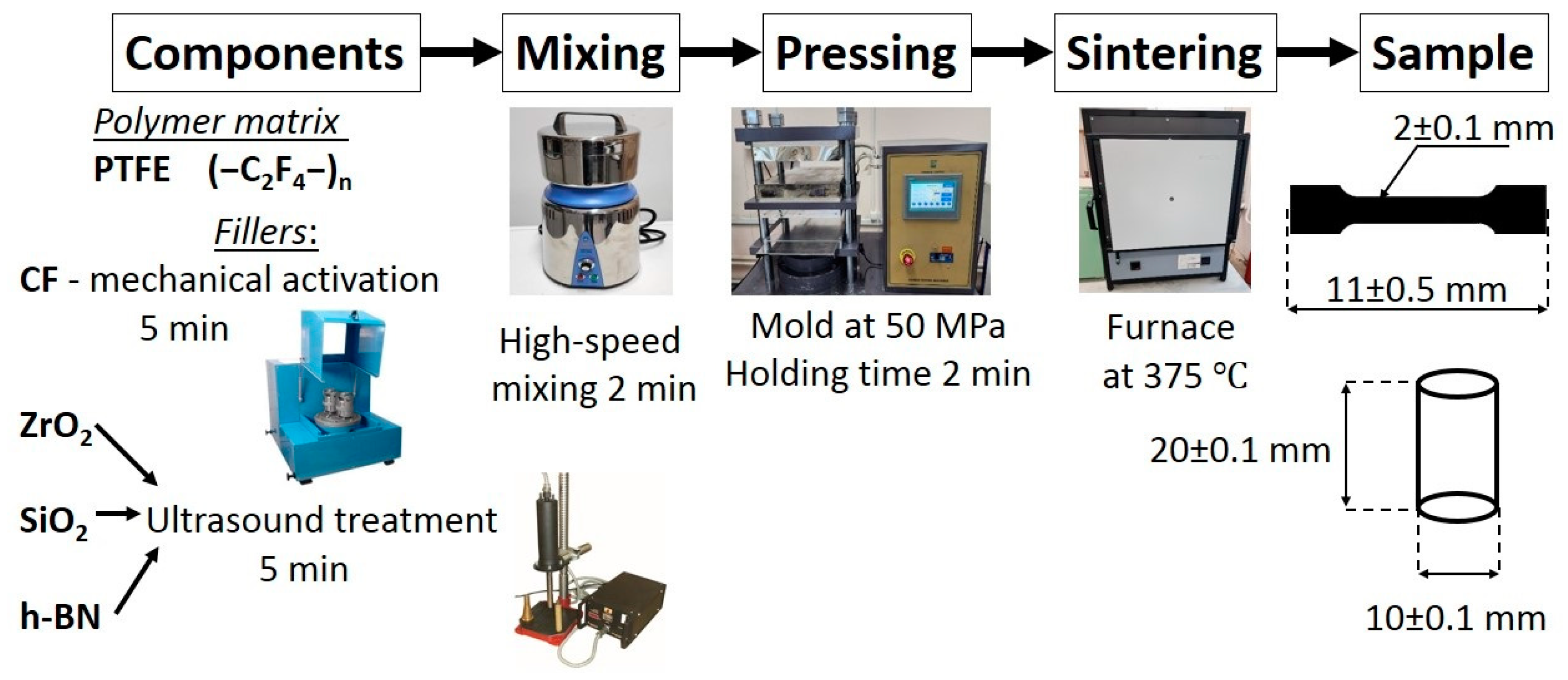
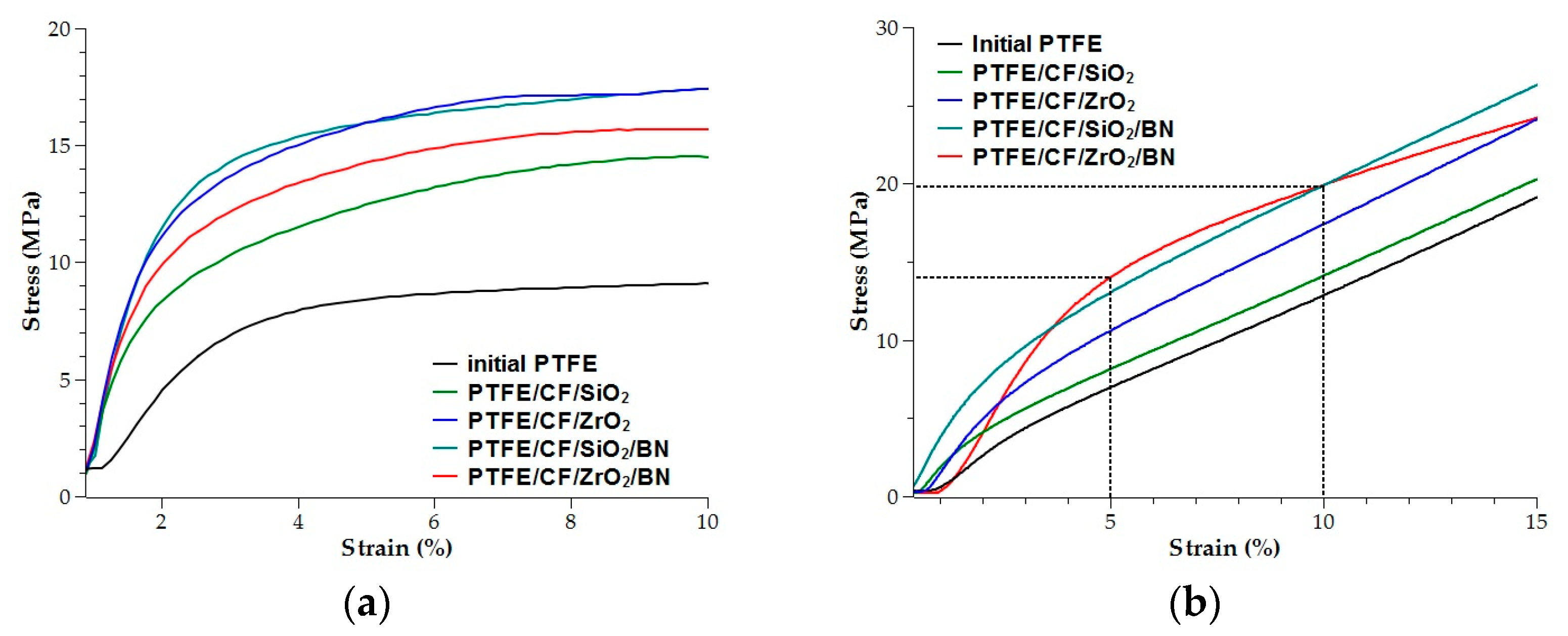
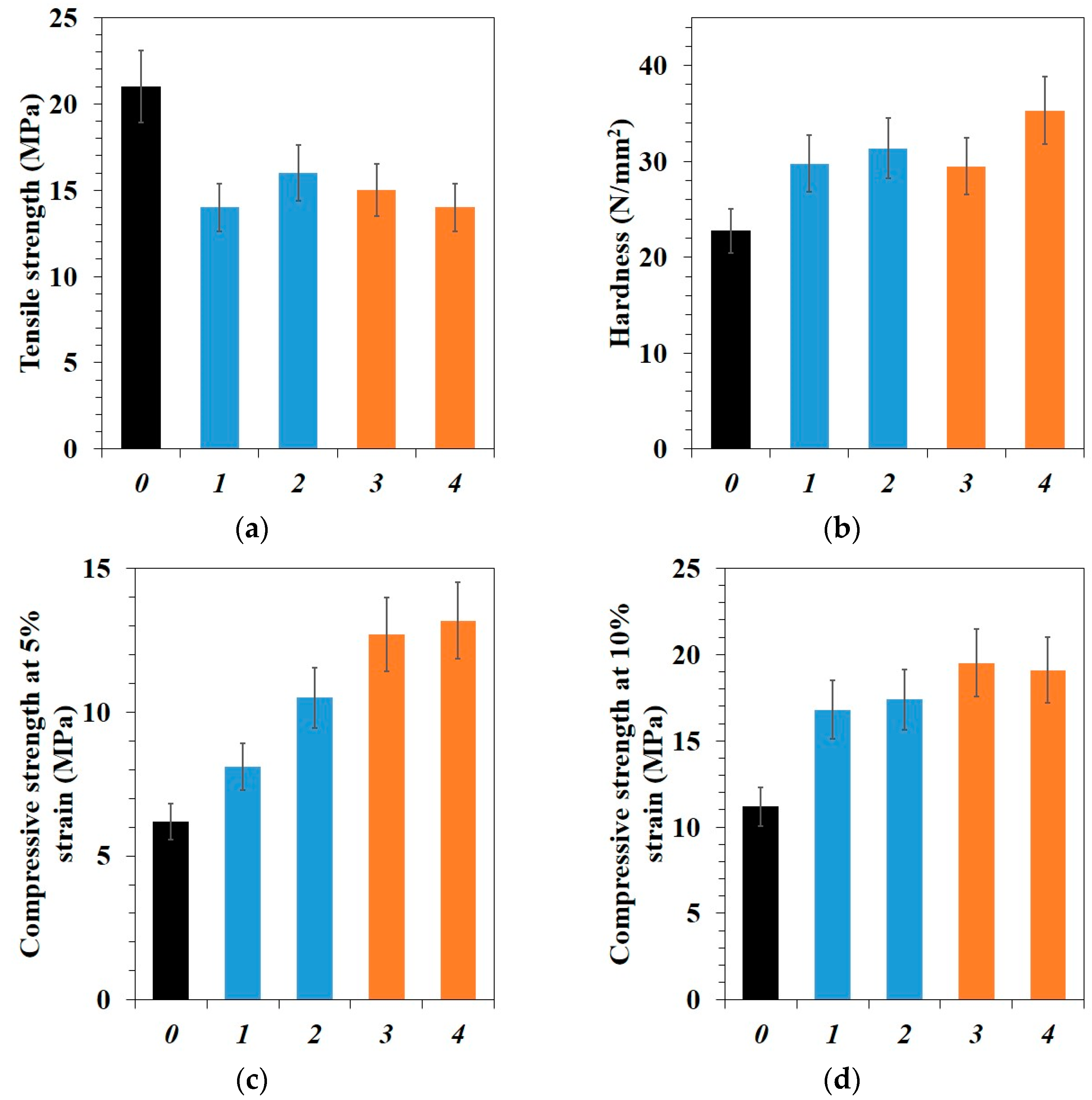
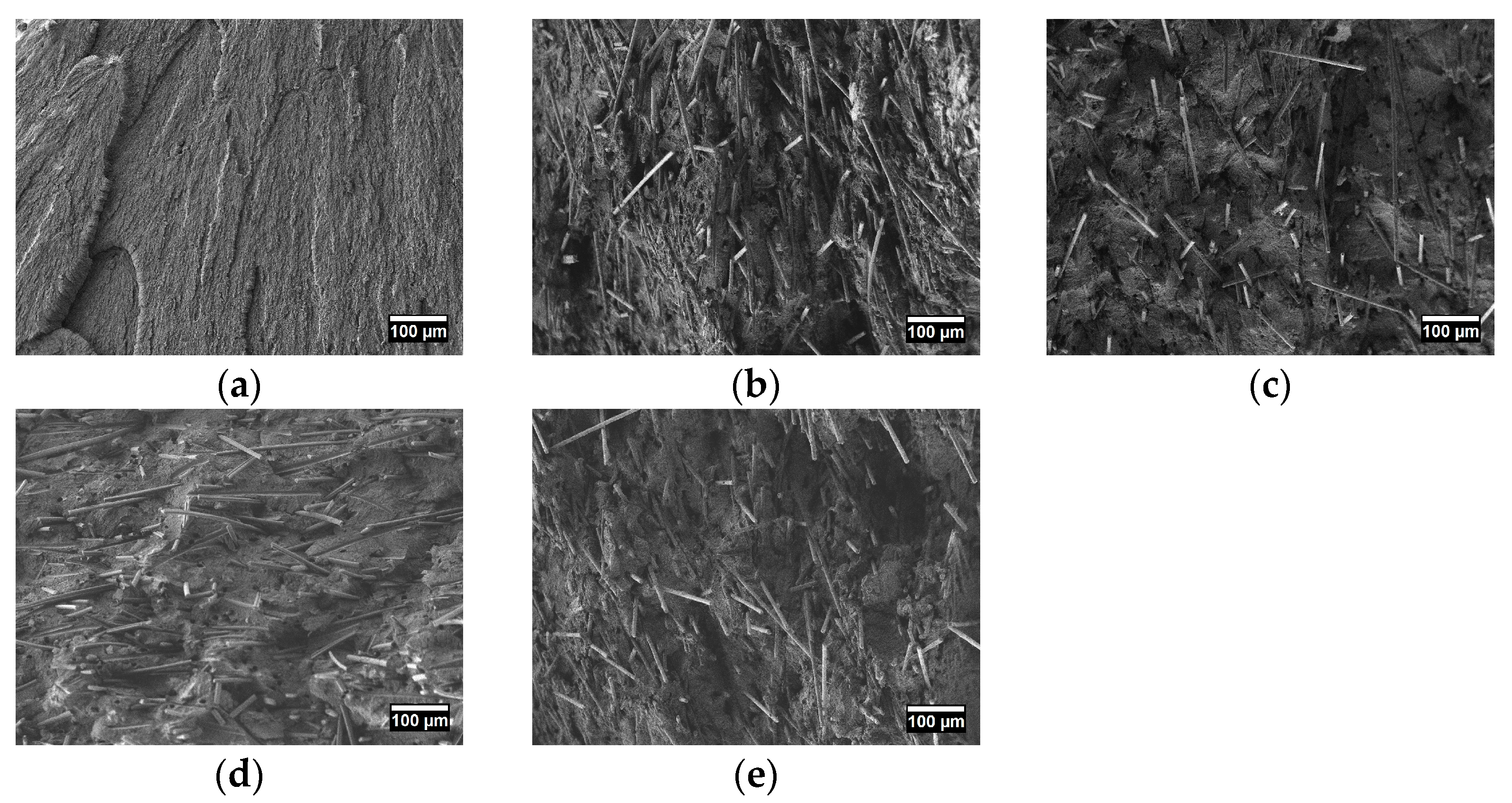
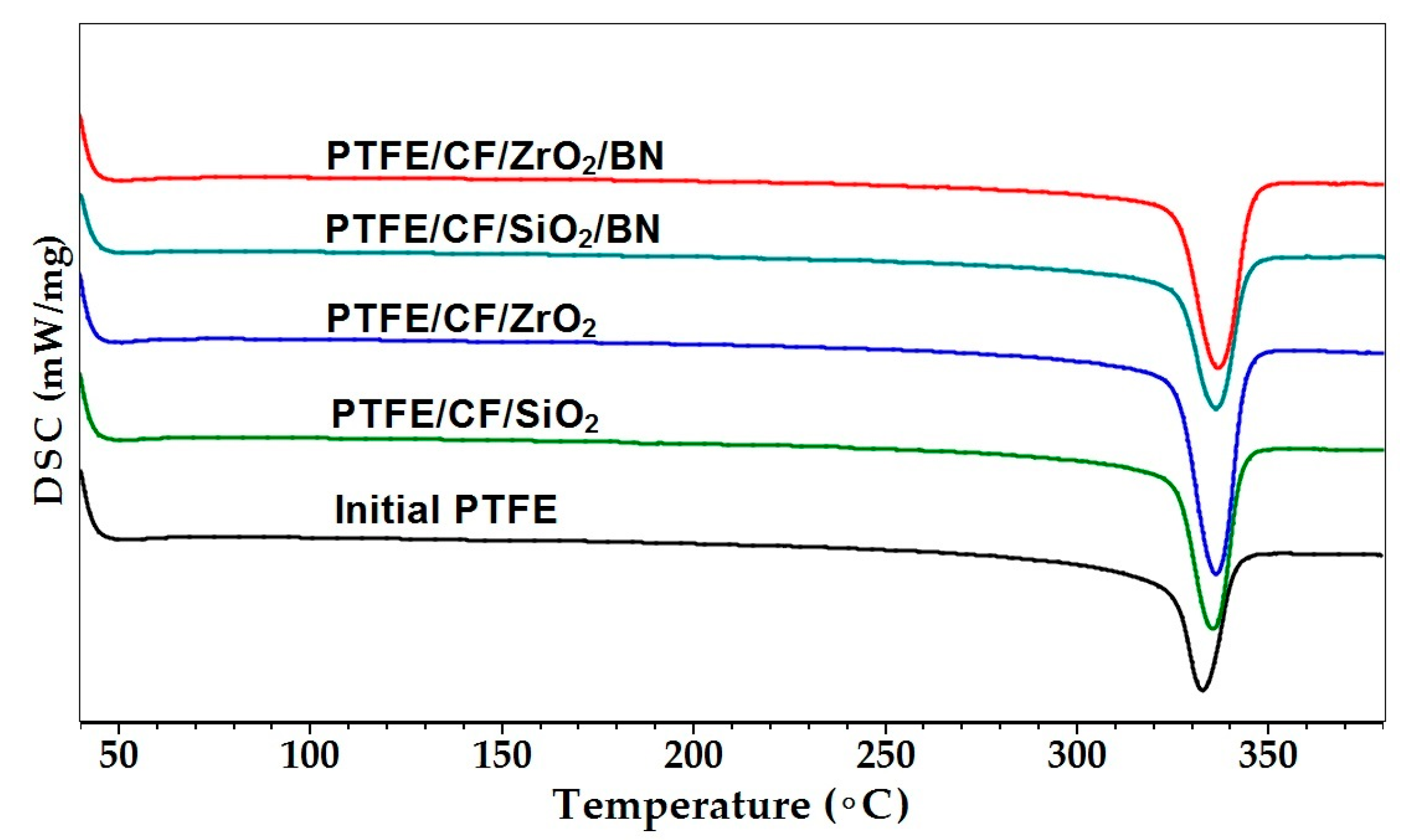
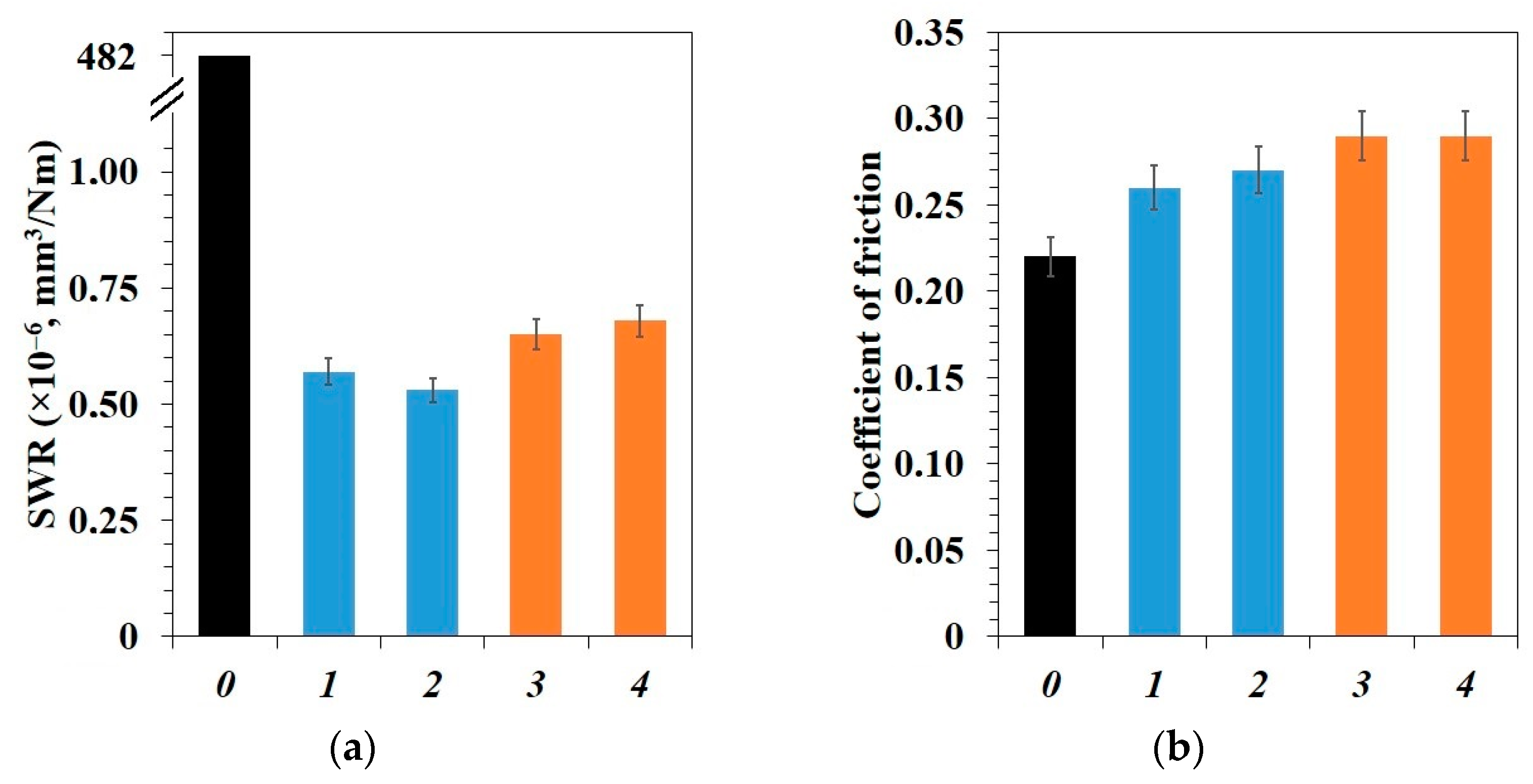
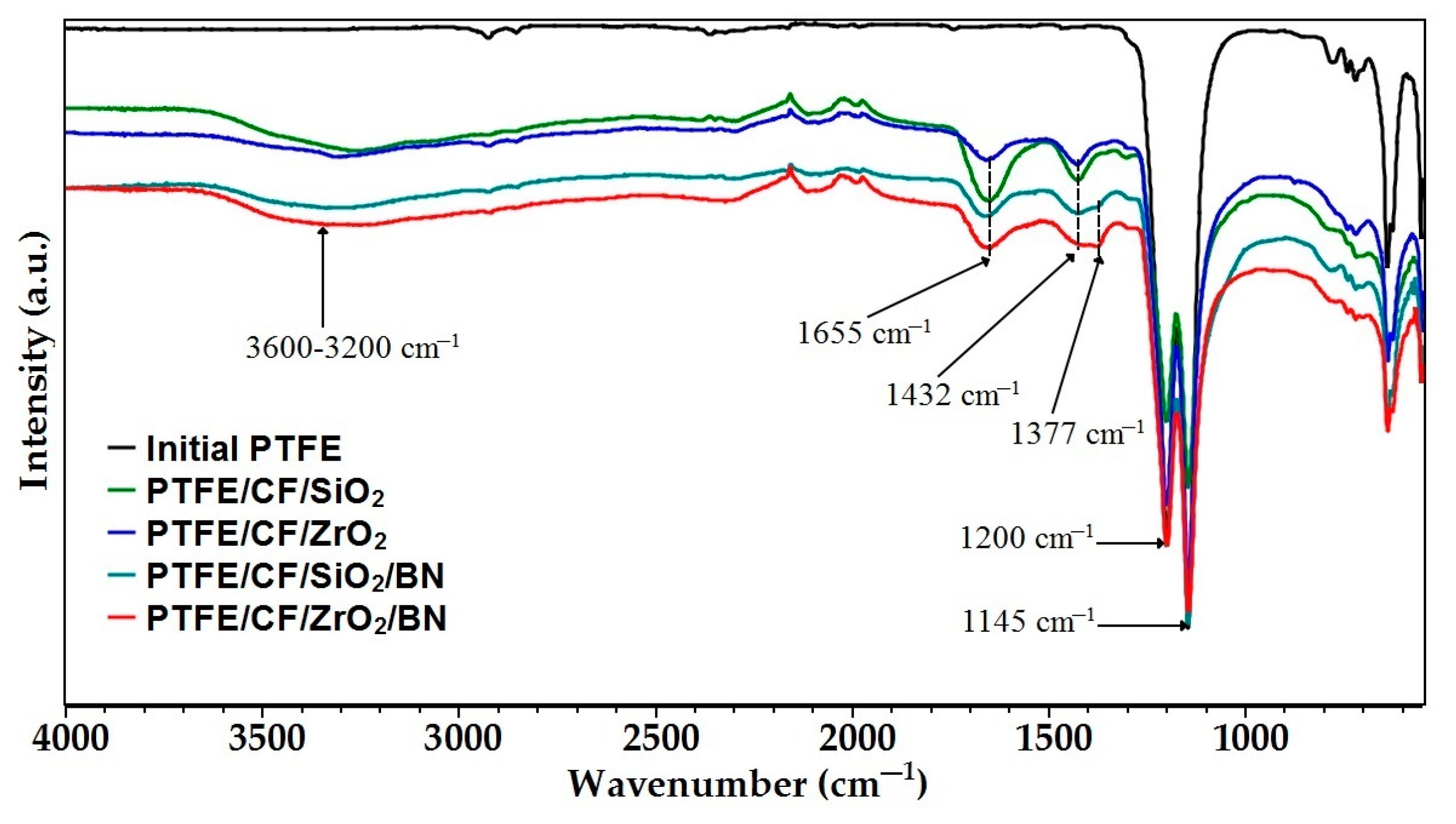
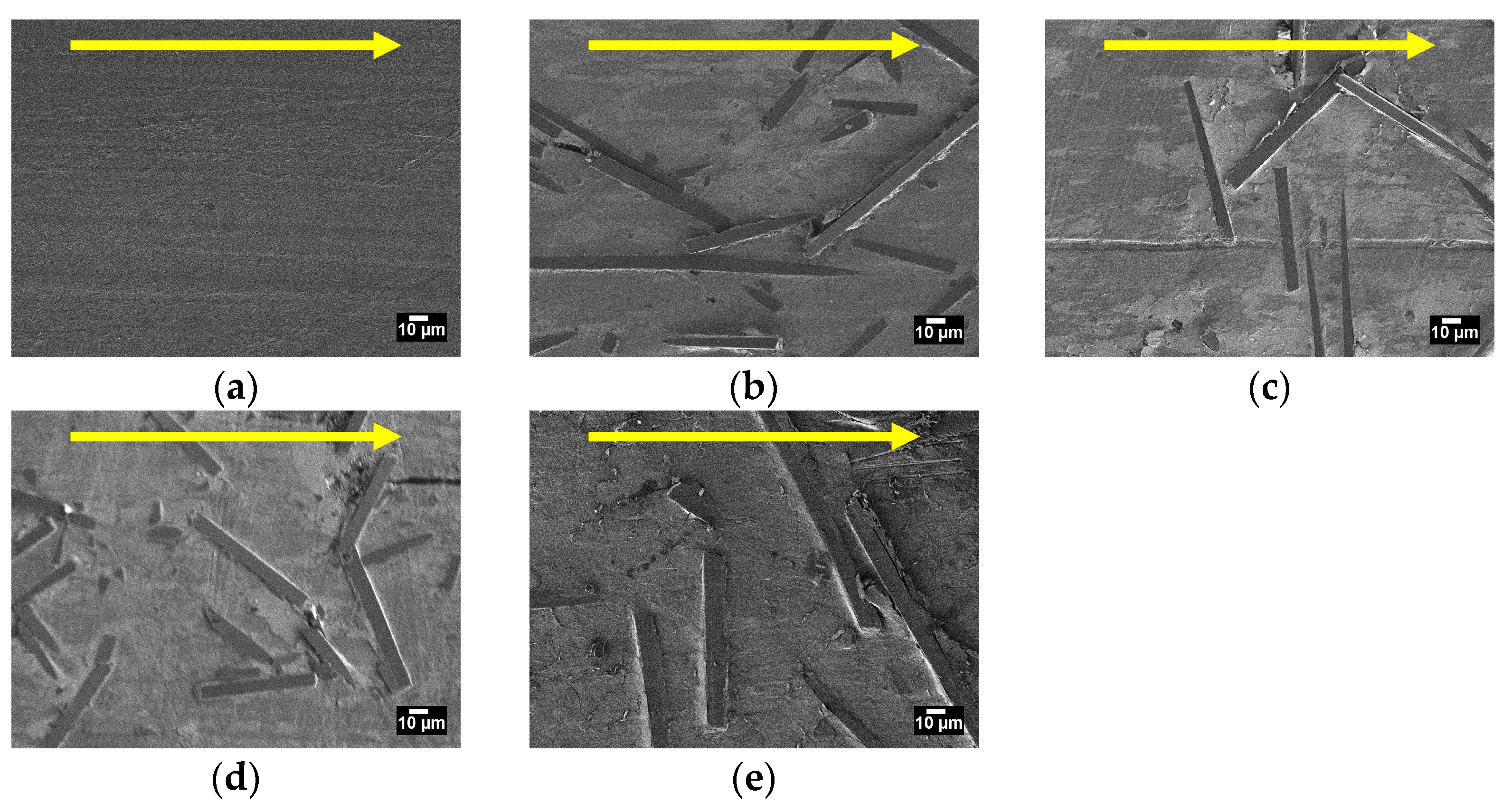

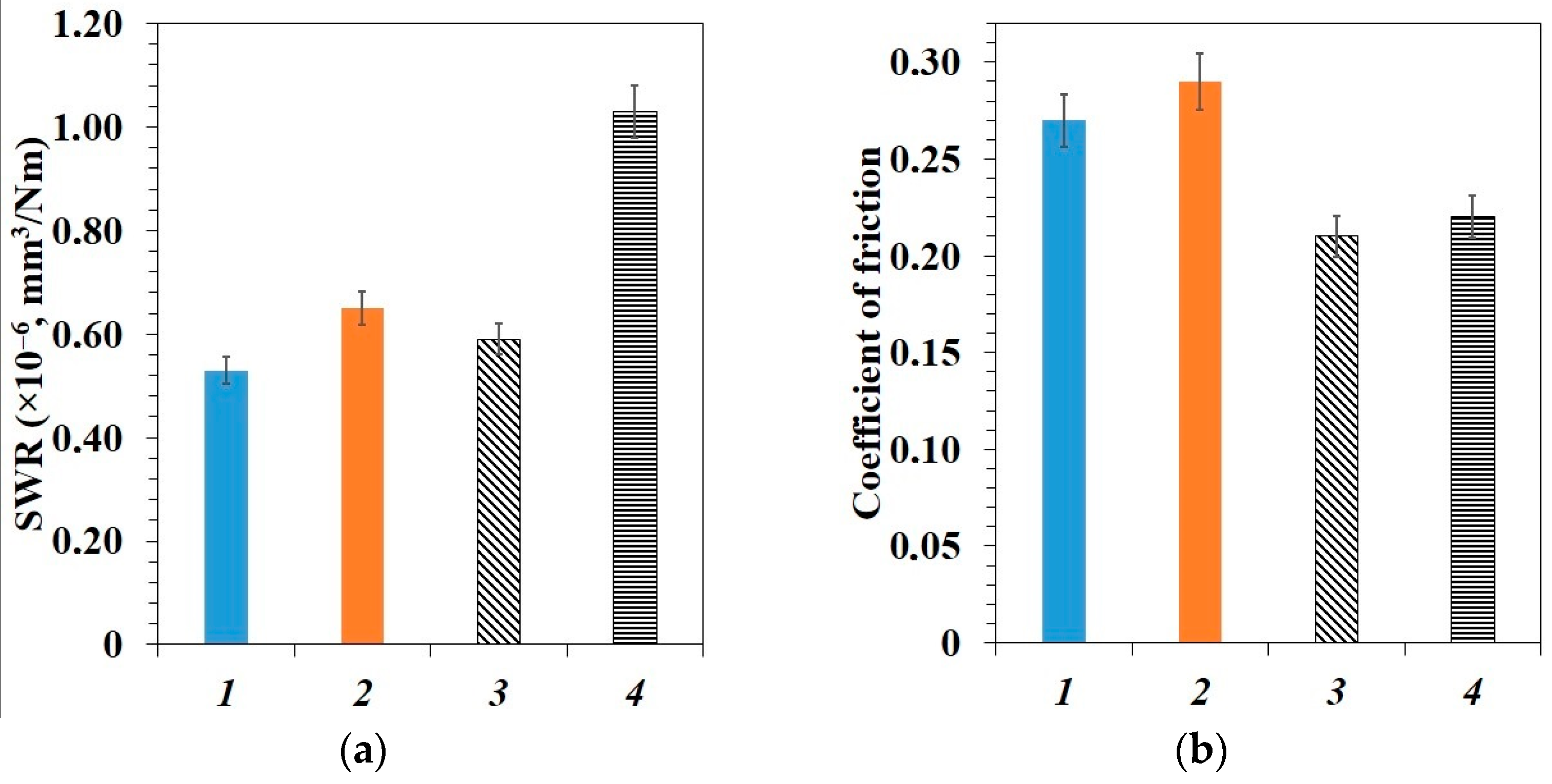
| Composite | Content of Polymer and Fillers, wt.% | ||||
|---|---|---|---|---|---|
| PTFE | CF | SiO2 | ZrO2 | BN | |
| Initial PTFE | 100 | - | - | - | - |
| PTFE/CF/SiO2 | 89 | 10 | 1 | - | - |
| PTFE/CF/ZrO2 | 89 | 10 | - | 1 | - |
| PTFE/CF/SiO2/BN | 88.5 | 10 | 1 | - | 0.5 |
| PTFE/CF/ZrO2/BN | 88.5 | 10 | - | 1 | 0.5 |
| Composite | Tm, °C | ΔHm, J/g | α, % | CLTE, 10−5, K−1 | ρ, g/cm3 |
|---|---|---|---|---|---|
| Initial PTFE | 332.8 | 34.3 | 41.9 | 26/3 | 2.16 |
| PTFE/CF/SiO2 | 335.5 | 39.6 | 48.3 | 17.5 | 1.92 |
| PTFE/CF/ZrO2 | 336.3 | 45.9 | 55.9 | 12.1 | 1.96 |
| PTFE/CF/SiO2/BN | 336.3 | 34.1 | 41.6 | 12.6 | 2.01 |
| PTFE/CF/ZrO2/BN | 336.9 | 38.1 | 46.5 | 7.8 | 2.06 |
Disclaimer/Publisher’s Note: The statements, opinions and data contained in all publications are solely those of the individual author(s) and contributor(s) and not of MDPI and/or the editor(s). MDPI and/or the editor(s) disclaim responsibility for any injury to people or property resulting from any ideas, methods, instructions or products referred to in the content. |
© 2023 by the authors. Licensee MDPI, Basel, Switzerland. This article is an open access article distributed under the terms and conditions of the Creative Commons Attribution (CC BY) license (https://creativecommons.org/licenses/by/4.0/).
Share and Cite
Vasilev, A.P.; Lazareva, N.N.; Struchkova, T.S.; Okhlopkova, A.A.; Danilova, S.N. Mechanical and Tribological Properties of Polytetrafluoroethylene Modified with Combined Fillers: Carbon Fibers, Zirconium Dioxide, Silicon Dioxide and Boron Nitride. Polymers 2023, 15, 313. https://doi.org/10.3390/polym15020313
Vasilev AP, Lazareva NN, Struchkova TS, Okhlopkova AA, Danilova SN. Mechanical and Tribological Properties of Polytetrafluoroethylene Modified with Combined Fillers: Carbon Fibers, Zirconium Dioxide, Silicon Dioxide and Boron Nitride. Polymers. 2023; 15(2):313. https://doi.org/10.3390/polym15020313
Chicago/Turabian StyleVasilev, Andrey P., Nadezhda N. Lazareva, Tatyana S. Struchkova, Aitalina A. Okhlopkova, and Sakhayana N. Danilova. 2023. "Mechanical and Tribological Properties of Polytetrafluoroethylene Modified with Combined Fillers: Carbon Fibers, Zirconium Dioxide, Silicon Dioxide and Boron Nitride" Polymers 15, no. 2: 313. https://doi.org/10.3390/polym15020313
APA StyleVasilev, A. P., Lazareva, N. N., Struchkova, T. S., Okhlopkova, A. A., & Danilova, S. N. (2023). Mechanical and Tribological Properties of Polytetrafluoroethylene Modified with Combined Fillers: Carbon Fibers, Zirconium Dioxide, Silicon Dioxide and Boron Nitride. Polymers, 15(2), 313. https://doi.org/10.3390/polym15020313








